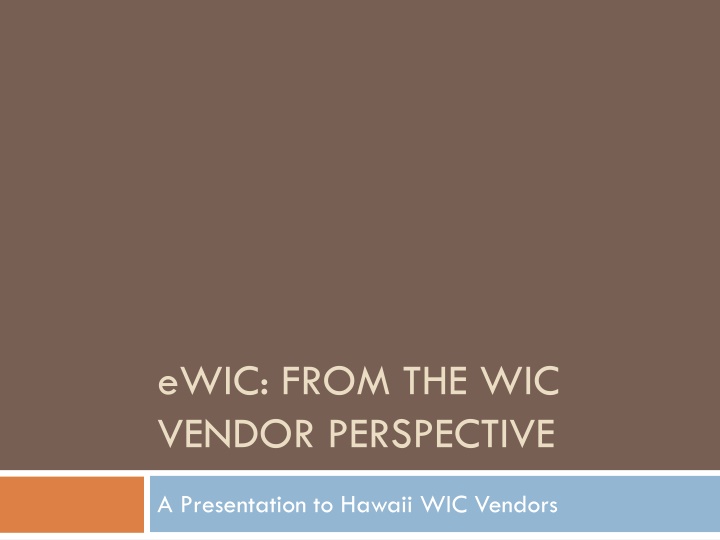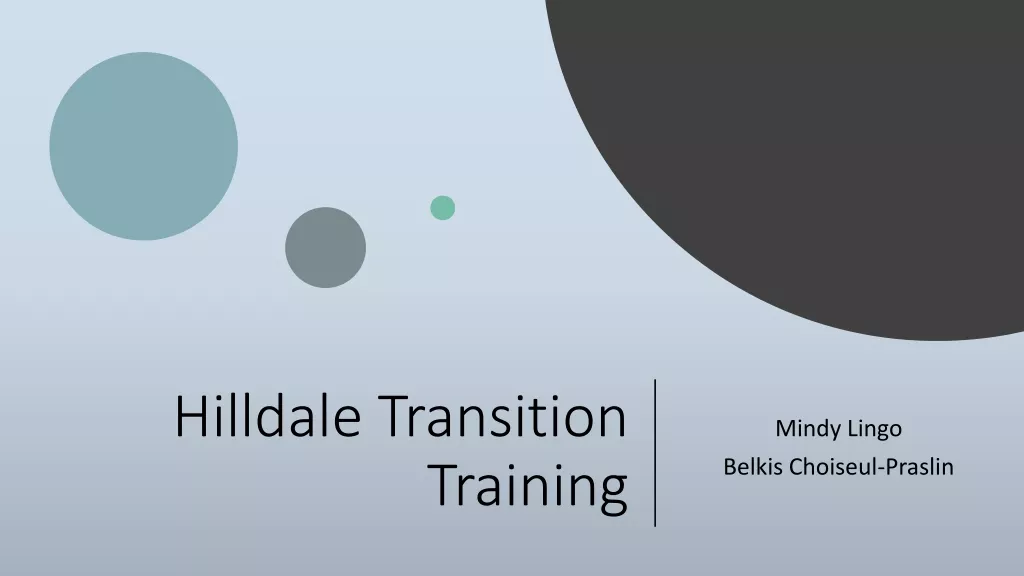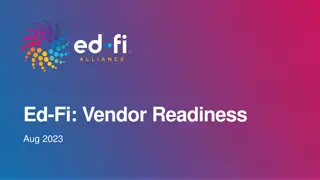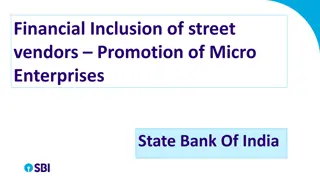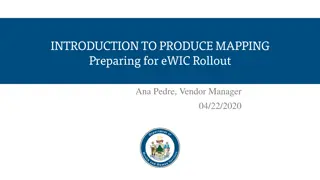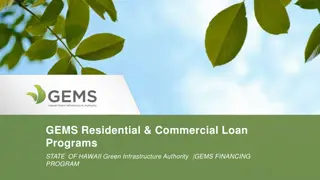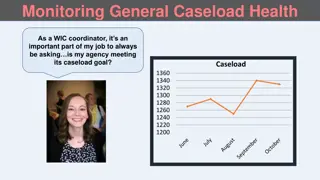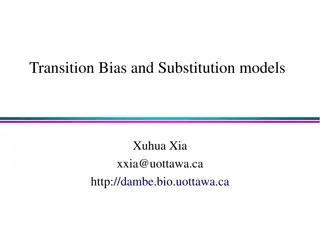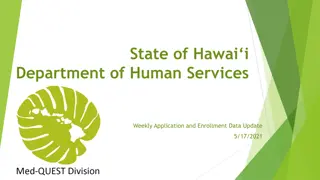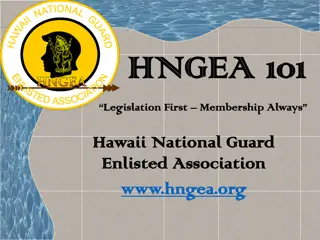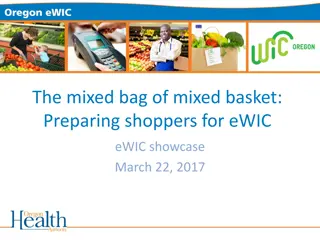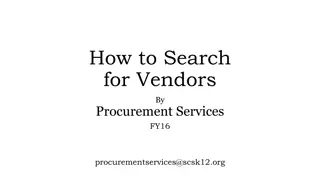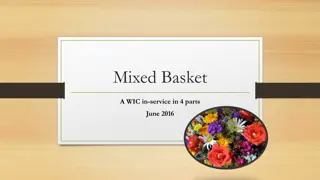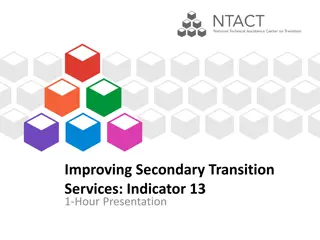eWIC Transition for Hawaii WIC Vendors
Explore the transition to eWIC (EBT) in Hawaii's WIC program from the vendor perspective. Learn about the background, challenges, benefits, and history of eWIC, as well as the role of MAXIMUS in planning support. Discover how other state agencies are operating eWIC and the basics of EBT technology. Get insights into the upcoming changes and requirements for vendors.
Uploaded on Sep 22, 2024 | 0 Views
Download Presentation

Please find below an Image/Link to download the presentation.
The content on the website is provided AS IS for your information and personal use only. It may not be sold, licensed, or shared on other websites without obtaining consent from the author.If you encounter any issues during the download, it is possible that the publisher has removed the file from their server.
You are allowed to download the files provided on this website for personal or commercial use, subject to the condition that they are used lawfully. All files are the property of their respective owners.
The content on the website is provided AS IS for your information and personal use only. It may not be sold, licensed, or shared on other websites without obtaining consent from the author.
E N D
Presentation Transcript
eWIC: FROM THE WIC VENDOR PERSPECTIVE A Presentation to Hawaii WIC Vendors
Introduction 2 The Hawaii WIC Program is in the process of planning for a transition to EBT, also known as eWIC, and has contracted with MAXIMUS for planning support. About MAXIMUS Provides eWIC planning and technical assistance More than 15 years experience with eWIC Provided planning support to more than 30 WIC State Agencies MAXIMUS role in the Hawaii eWIC project Assisting in planning and analysis activities for eWIC Supporting development of required documentation for USDA and eWIC procurement Providing technical assistance as needed eWIC: From the Vendor Perspective
Purpose of this Presentation 3 eWIC is coming, there is a mandate that all WIC State Agencies convert to eWIC issuance by 2020 HI WIC is currently in the planning phase of the eWIC project This presentation provides high level information for stores about how eWIC works eWIC: From the Vendor Perspective
Overview 4 Background and History Basics In the Store Benefits and Challenges Next Steps eWIC: From the Vendor Perspective
5 eWIC Background & History eWIC: From the Vendor Perspective
eWIC History 6 Year(s) Milestone 1995 2002 2004-09 2005 First smartcard eWIC pilot in Wyoming Wyoming is first state-wide smartcard eWIC system Texas and New Mexico rollout smartcard eWIC Online eWIC pilots implemented Michigan and Washington 2006 2009 2010 Kentucky begins development of an online system Michigan, first state-wide online WIC EBT system Congress mandates eWIC by 2020 eWIC: From the Vendor Perspective
State Agencies Operating eWIC 7 14 State Agencies Online Nationwide Chickasaw Nation Virginia Florida Wisconsin Kentucky West Virginia Massachusetts Indiana (Pilot) Michigan Iowa (Pilot) Nevada Oklahoma (Pilot) Oregon Vermont (Pilot) eWIC: From the Local Agency Perspective
8 eWIC Basics eWIC: From the Vendor Perspective
EBT Technology 9 Uses magnetic stripe cards to access account information on the eWIC system Like debit or SNAP/cash EBT Transactions occur live between the retail system and the eWIC system The eWIC system calculates the payment amount based on transactions that occur during a set 24 hour timeframe eWIC: From the Vendor Perspective
Paper vs. eWIC: Issuance 10 Paper System eWIC Food items, sizes and quantities are printed on a paper check Food items are represented in an account, using a coding system of food categories, and total amount available for each food category Checks are issued to each participant within a household Participant benefits are combined into one household account = = 52,000 eWIC: From the Vendor Perspective
Food Categorization 11 Foods are represented by codes for: Category (Cat) Subcategory (Subcat) Cat is the high level food group, examples: Low Fat/Fat Free Milk Legumes (Beans) Subcat is the specific food within the Cat group, examples: Skim milk; powdered milk; lactose free milk Peanut butter; dry beans/peas; canned beans eWIC: From the Vendor Perspective
Benefit Balance 12 A WIC benefit balance is a combination of food balances. For example: eWIC: From the Vendor Perspective
Food Categorization 13 Food Item Cat Subcat Description Unit of Measure 000 Cheese all types Pound 001 Cheese Pound Cheese 02 002 Reduced Fat Cheese Pound 003 Low Sodium Cheese Pound 004 Tofu Pound 000 Eggs all types Dozen Eggs 03 001 Fresh eggs in Dozen Cartons Dozen 000 Cereal all types Ounce Cereal 05 001 Cereal - hot and cold Ounce 000 Legumes/Beans all types Cont 001 Peanut Butter 18 oz Cont Legumes/ Beans 06 002 Dry or Can Beans/Peas 16 oz Cont 003 Canned Beans (4 cans = 1 Container) Cont This example is from the National Food Category / Subcategory List. Specific offerings/sizes may vary from state to state. eWIC: From the Vendor Perspective
Access to Balance Information 14 eWIC system always has the current balance Balance can be obtained through: Retail or clinic balance inquiry Automated phone line Web portal Phone app Text messaging Transaction data available immediately as soon as transaction is processed eWIC: From the Vendor Perspective
Fruit & Vegetables 15 Fruit & Vegetable Check in eWIC called Fruit & Vegetable Benefits (FVB) FVBs are not treated as different, but as a Food Category Value represented in dollars and cents If FVB not used at one time, remaining FVB are available through the end of the issuance period eWIC: From the Vendor Perspective
Fruit & Vegetable Balance 16 Below is an example of how the FVB will appear in an eWIC balance eWIC: From the Vendor Perspective
Benefit Aggregation 17 Benefits for participants within a household are combined into a single household account. The benefits of all participants in the household can be accessed from one card. Requires that all benefits issued in a household/family have the same last date to use. Families experience the ability to better manage their benefits. eWIC: From the Vendor Perspective
Paper vs. eWIC: Redemption 18 Paper WIC Redemption eWIC Redemption Participants must sign WIC items are separated Cashier must: Know WIC items Check valid use dates Determine if items can be purchased Record purchase amount Vendor must write the vendor number on the checks and deposit checks in bank. Cardholders use a PIN WIC items may not have to be separated (depends on store system) The system determines items that can be purchased Automatic payment
UPCs, PLUs and APLs 19 All UPCs and PLUs for approved WIC items are distributed to retail systems in the Approved Product List (APL) file. UPCs and PLUs are associated with Categories/ Subcategories in the APL Retail systems download the APL everyday to process new or updated items The APL is used as part of the purchase along with the balance to identify what can be purchased by the cardholder eWIC: From the Vendor Perspective
How UPCs are Used in Redemption 20 eWIC: From the Vendor Perspective
21 eWIC in the Store eWIC: From the Vendor Perspective
Retail Requirements for eWIC 22 The retail system must be able to: Use the authorized products list (APL) to identify WIC products based on a UPC or PLU during a purchase Use the account balance in determining items that can be purchased in the eWIC transaction Electronically submit eWIC transactions The retail system must be certified Vendor must maintain a bank account for the ACH transaction for eWIC settlement payments
Retail System Alternatives 23 Integrated Cash Register Stand-Beside Point-of-Sale Typical for chain and multi- lane or vendors with cash registers that are eWIC ready, but encouraged for all Operate like all other tender types Typically separate equipment not required Streamlined approach to eWIC Separate from store cash register system Double scan with key entered price and discount amounts Daily totals are reported separately, payment separate from credit and debit Can work over dial-up, or high speed internet connection eWIC: From the Vendor Perspective
Integrated Systems/Software 24 IBM SurePOS ACE Retalix StoreLine IBM 4680-4690 Supermarket Application Retalix R10 RORC viPOS LOC Software Store Management Suite (SMS) StoreNext ISS45 V7 StoreNext ISS45 V8 Market Master StoreNext ScanMaster V2 NCR Advanced Checkout Solution (ACS) NCR Advanced Checkout Solution / Independent Retailer (ACS/IR) Please note this is not an all inclusive list eWIC: From the Vendor Perspective
eWIC Retail Transactions 25 Balance Inquiry Purchase Transaction Void/Reversal eWIC: From the Vendor Perspective
Purchase Transaction (Part 1) 26 Card is swiped and cardholder enters their PIN System validates the card and PIN Balance obtained from the eWIC system Each food item that has been scanned is: Compared to APL maintained locally to determine if it is an allowable WIC item Compared to cardholder balance to determine if there is sufficient balance to purchase eWIC: From the Vendor Perspective
Purchase Transaction (Part 2) 27 Retail system captures data including item prices and discounts to send to eWIC system The household s balance is reduced by the amounts (qty) of items being purchased If an item price exceeds the Not To Exceed (NTE) amount, the item is paid up to the NTE and total payment amount adjusted The eWIC system provides the retail system with approval, paid amount A receipt showing purchase details, the new food balance, and last date to spend for remaining benefits eWIC: From the Vendor Perspective
28 Sample Receipts
29 eWIC Benefits & Challenges eWIC: From the Vendor Perspective
Benefits and Challenges 30 There are many benefits to implementing eWIC, but there are always challenges when implementing a new system or process The experiences in other states have shown that the benefits of eWIC outweigh challenges When asked, the majority of stores would rather stay with eWIC than return to paper eWIC: From the Vendor Perspective
Vendors 31 Benefits Challenges Checkout processes more efficient (no signing, dating, etc) Transactions are less error prone, do not rely on cashier to validate Easier and faster to receive payment, vendors are paid within two business days Vendors experience back office labor savings, no longer necessary to count and deposit or process checks Issues related to rejected checks are eliminated Updates to cash register systems eWIC is different from other tenders, additional training needed When items are expected to be paid by eWIC are not, troubleshooting is not always straight forward Stores with stand-beside equipment require double scanning / price entry
Participants 32 Benefits Challenges Less stigma than paper benefits, similar to a debit card transaction PIN provides security, validates transaction All benefits in one account/card improves benefit management Improved shopping experience, participants can buy the quantities they need, rather than having to use the whole check at once Must keep track of benefit balance Different store cash register systems have different purchase flows that participants will need to understand Important to know current balance and purchase correct WIC foods because they may not know an item will not be paid by eWIC until end of transaction May have bought unauthorized items previously that they think are WIC items
Next Steps eWIC: From the Vendor Perspective
eWIC Planning Project Tasks 34 Stakeholder engagement planning Cost analysis Alternative analysis and recommendations Federally required implementation plan document eWIC system contracting activities eWIC: From the Vendor Perspective
WIC Vendor Survey 35 The State will be requesting that vendors complete a survey to capture information used in eWIC planning activities Your response to the survey is important and will help in accurately developing eWIC implementation plans eWIC: From the Vendor Perspective
Timeline 36 The planning phase will be completed by Spring 2017 Planning activities will determine the eWIC implementation schedule After planning is complete, next steps include: Procure an eWIC service provider Prepare for implementation Pilot eWIC followed by statewide rollout eWIC: From the Vendor Perspective
37 Questions? If you have more questions, please email them to: Timothy.freeman@doh.hawaii.gov eWIC: From the Vendor Perspective
